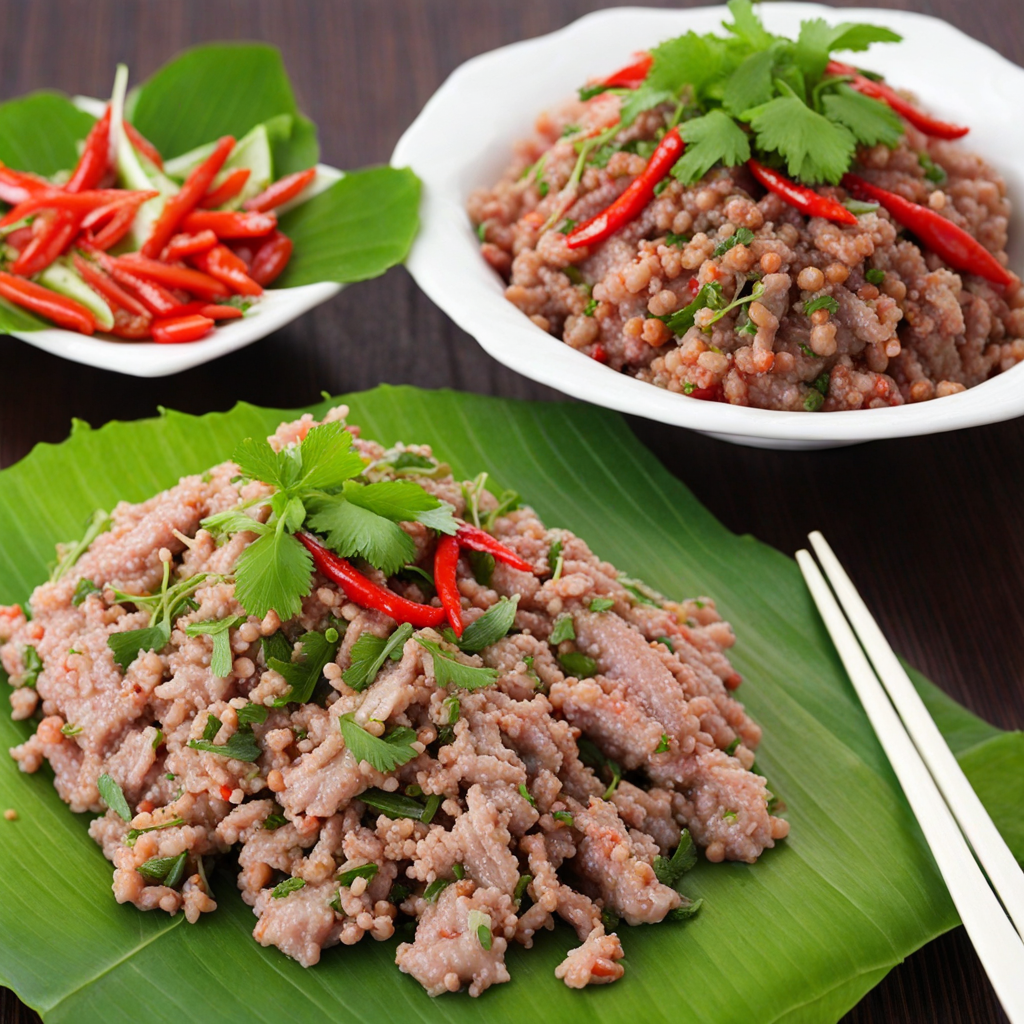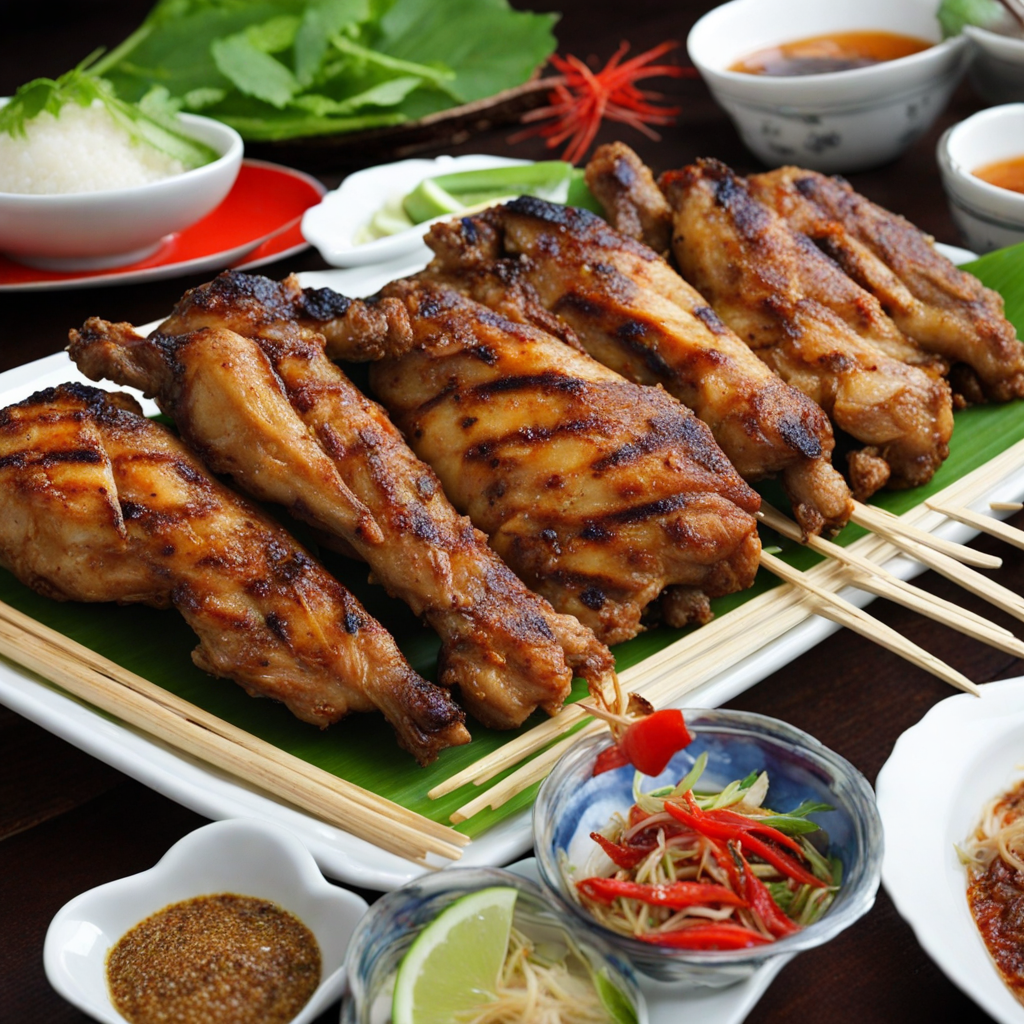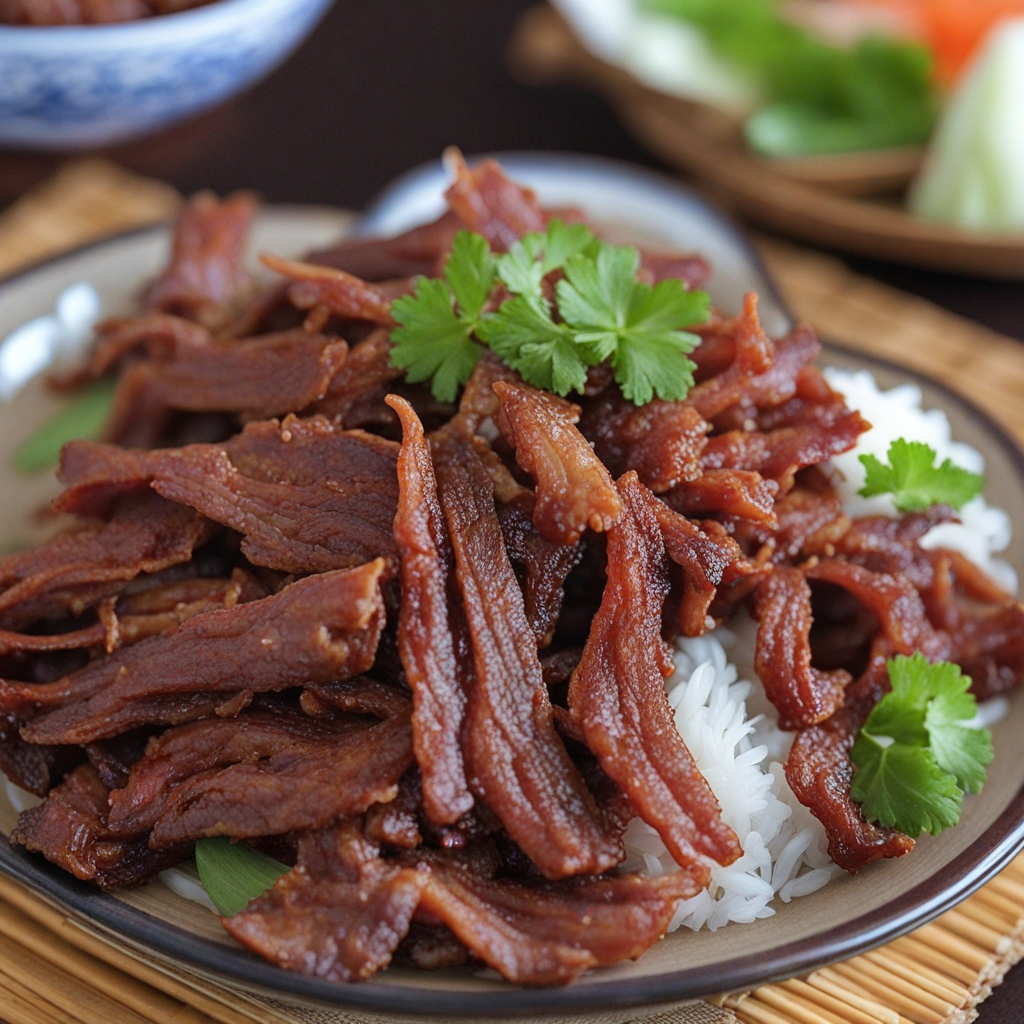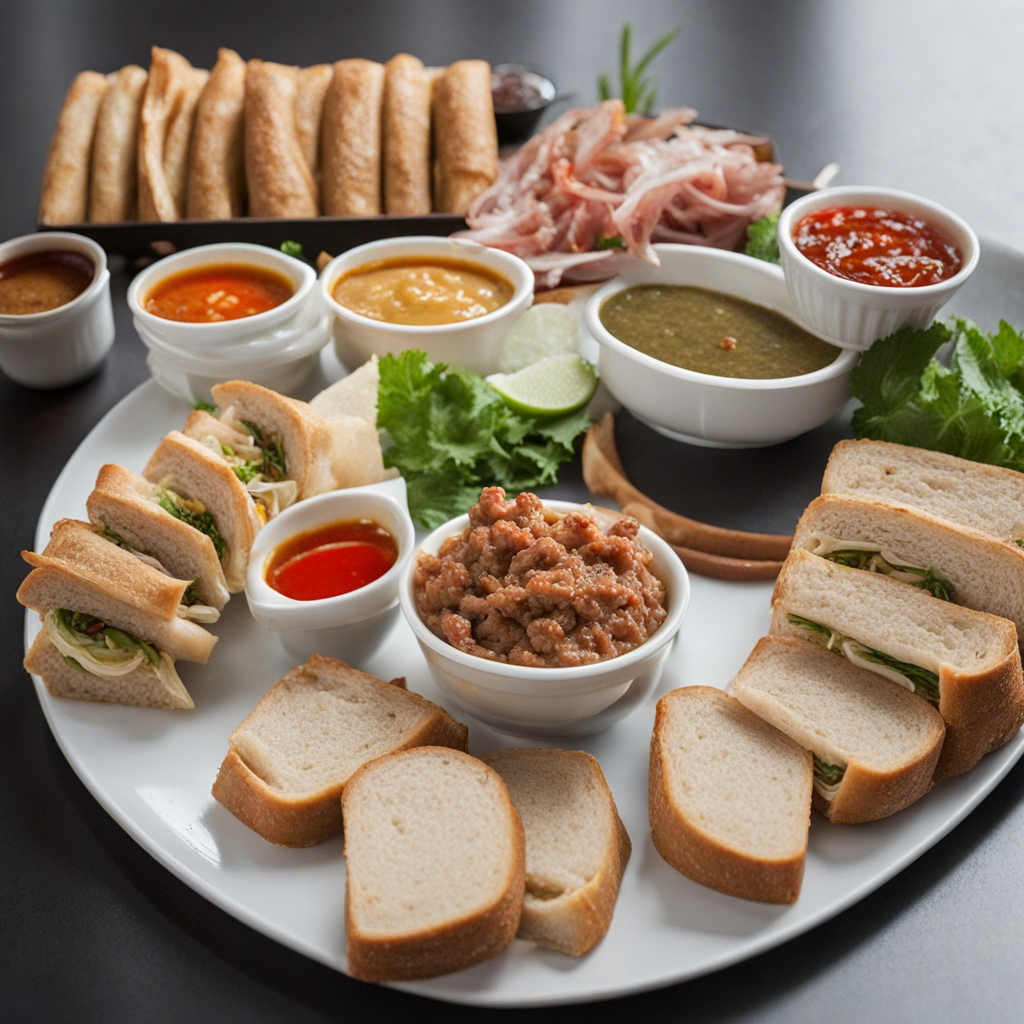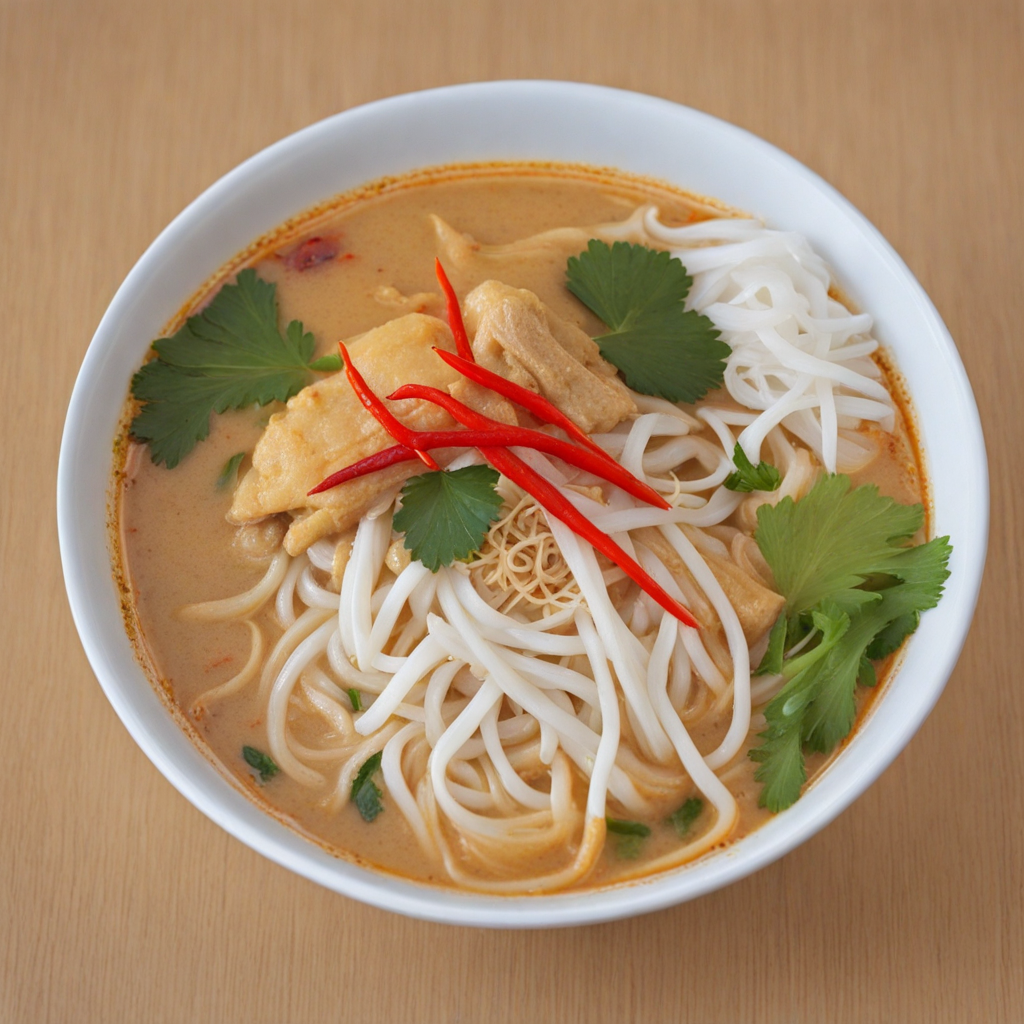Laap
Laap, a traditional dish from Laos, is a vibrant and aromatic salad that celebrates the essence of fresh ingredients and bold flavors. This dish primarily features minced meat, often chicken, beef, or pork, which is combined with fragrant herbs like mint, cilantro, and green onions. The meat is typically cooked by lightly frying or sometimes served raw, showcasing the freshness of ingredients while enhancing the dish's distinctive taste. The addition of toasted rice powder lends a delightful crunch and depth to the texture, creating a perfect harmony with the tender meat and herbs. What truly sets Laap apart is its bold dressing, usually made from lime juice, fish sauce, and chili flakes, offering a tangy and spicy kick that awakens the palate. This zesty concoction not only elevates the flavors but also reflects the balance of salty, sour, and spicy that is characteristic of Laotian cuisine. Laap can be enjoyed as a main dish or as part of a larger meal, often accompanied by sticky rice, which complements the intense flavors beautifully. Laap is more than just a dish; it's a cultural experience that embodies the communal spirit of Lao dining. Often served at gatherings and celebrations, it is usually presented with fresh vegetables like lettuce, cucumber, and cabbage, allowing diners to create their own wraps. This interactive aspect adds to the enjoyment, as each bite can be customized to individual taste preferences. Discovering Laap is a journey into the heart of Laotian flavors, offering a unique and unforgettable taste experience that invites you to savor the richness of its culinary heritage.
How It Became This Dish
Origin of Larb Larb, a traditional dish from Laos, is considered the national dish of the country and is deeply rooted in Laotian culture. Its origins can be traced back to the ancient practices of the Lao people, who relied heavily on local ingredients and culinary techniques. The dish is thought to have been created by the various ethnic groups that inhabit the region, particularly the Lao Loum, or lowland Lao, who have significantly influenced Laotian cuisine. Historically, larb was made with whatever meat was available, including fish, chicken, pork, or beef, and it remains a versatile dish that reflects the agricultural lifestyle of the Lao people. The name "larb" itself is derived from the Lao word "lap," which means to chop or mince. This technique of finely chopping meat, combined with an array of fresh herbs, spices, and other ingredients, creates a dish that is both vibrant and complex in flavor. The preparation of larb is often a communal activity, reflecting the strong social ties within Laotian communities. Families would gather to prepare the dish, which has always been more than just a meal; it symbolizes togetherness and shared cultural practices. \n\n Cultural Significance of Larb Larb holds a significant place in Laotian culture and is often associated with important ceremonies and festivals. It is commonly served during celebrations such as weddings, religious festivals, and family gatherings, highlighting its role in uniting people and enhancing communal bonds. The dish's preparation and presentation are often seen as an art form, showcasing the cook's skill and care in creating a meal that is both aesthetically pleasing and flavorful. Moreover, larb is not just a culinary staple; it also has spiritual connotations. In many Laotian villages, food is believed to hold the essence of life and is often prepared with intentions of respect and gratitude. The consumption of larb, particularly during auspicious occasions, is thought to bring good fortune and prosperity. Additionally, the inclusion of fresh herbs, such as mint and cilantro, reflects the Lao belief in the importance of health and wellness, as these ingredients are imbued with medicinal properties. \n\n Ingredients and Variations Traditional larb is made from minced meat, but its versatility has led to countless variations. The key ingredients typically include lime juice, fish sauce, and roasted rice powder, which not only add depth to the flavor but also create a unique texture. Fresh herbs and vegetables are essential components, as they contribute freshness and brightness to the dish. Common herbs used in larb recipes include mint, cilantro, and green onions, while vegetables like cucumber and cabbage often accompany the dish as refreshing sides. In terms of meat, the most popular versions of larb utilize chicken, beef, or pork. However, in some regions, particularly in northeastern Laos, fish or even game meats like venison may be used. The dish can also be made vegetarian or vegan, substituting meat with tofu or mushrooms, ensuring that it remains accessible to a wider audience. Each variation reflects local tastes and the availability of ingredients, which has helped larb evolve over time while maintaining its core identity. \n\n Regional Differences While larb is recognized as the national dish of Laos, regional differences significantly influence how it is prepared and enjoyed. In the northern regions, larb is often drier and spicier, incorporating a range of local chilies and herbs. In contrast, southern Laos tends to favor a wetter version, where the meat is more marinated and served with a side of sticky rice. This divergence not only highlights the distinct culinary preferences of different regions but also showcases the rich tapestry of Lao culture. Further, larb is often linked to the ethnic diversity of Laos. Various ethnic groups, including the Hmong, Khmu, and Tai, have their own interpretations of the dish, which may include unique spices or cooking methods. For instance, Hmong larb may incorporate a variety of spices that are not commonly found in traditional Lao larb, reflecting their distinct cultural heritage. This regional variation is a testament to the adaptability of larb, allowing it to resonate with a wide array of cultural identities across Laos. \n\n Influence of Larb beyond Laos As the Laotian diaspora has spread across the globe, so too has the popularity of larb. In countries like the United States, Australia, and France, Laotian communities have introduced larb to diverse audiences, leading to increased interest in Southeast Asian cuisine. Restaurants serving Laotian dishes have emerged, often placing larb at the forefront of their menus. This has not only helped to popularize the dish but has also fostered a greater appreciation for Laotian culinary traditions. Moreover, larb has often been featured in food festivals and culinary events, showcasing its versatility and appeal. Its presence in international food culture highlights the interconnectedness of global culinary practices, where traditional dishes like larb can evolve while retaining their cultural significance. Chefs often experiment with larb, incorporating fusion elements or contemporary cooking techniques, thus drawing attention to the rich heritage of Laotian cuisine. \n\n Modern Adaptations and Health Trends In recent years, larb has also adapted to fit modern health trends, with an increasing focus on fresh, healthy ingredients. The use of lean meats, fresh vegetables, and herbs aligns with the growing demand for nutritious and wholesome meals. Many restaurants and home cooks have embraced the dish’s flexibility, creating variations that cater to dietary preferences, including gluten-free and low-carb options. Additionally, larb's popularity on social media platforms has contributed to its resurgence, with food influencers and bloggers showcasing various recipes and adaptations. This online presence has allowed larb to reach new audiences, encouraging people to explore Laotian cuisine and its flavors. As a result, larb has become a dish that not only represents Laos but also embodies the global appreciation for authentic, flavorful cooking. \n\n Conclusion Larb is more than just a dish; it is a cultural emblem that encapsulates the rich history and traditions of Laos. From its ancient origins to its modern adaptations, larb continues to evolve while preserving its core identity as a beloved national dish. Its communal preparation, diverse variations, and deep-rooted significance within Laotian culture ensure that larb will remain a cherished part of the culinary landscape for generations to come. Through its journey, larb has transcended borders, inviting people from all walks of life to experience the flavors and traditions of Laos.
You may like
Discover local flavors from Laos


